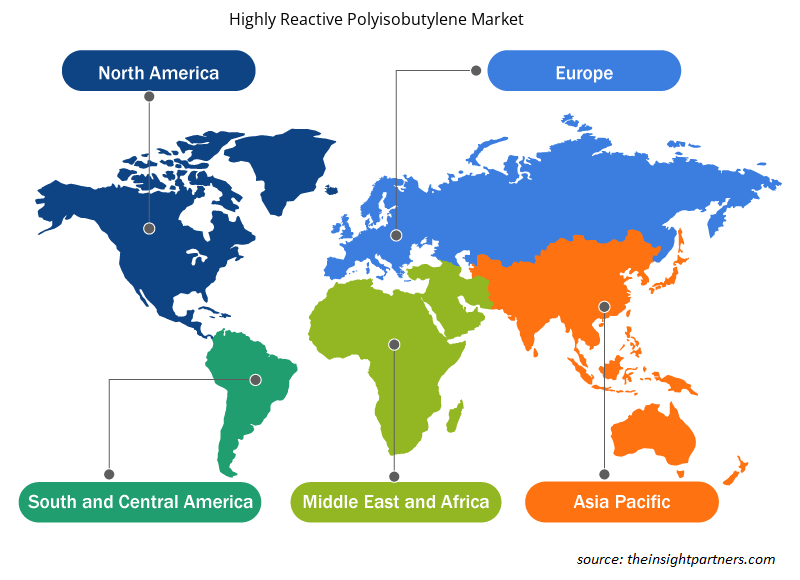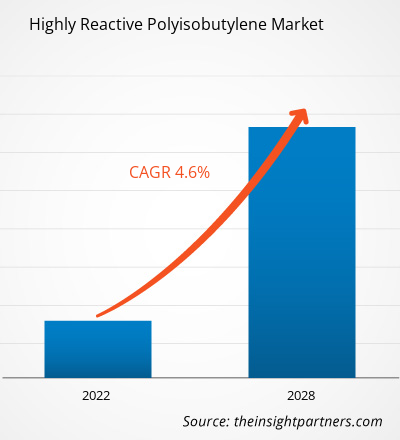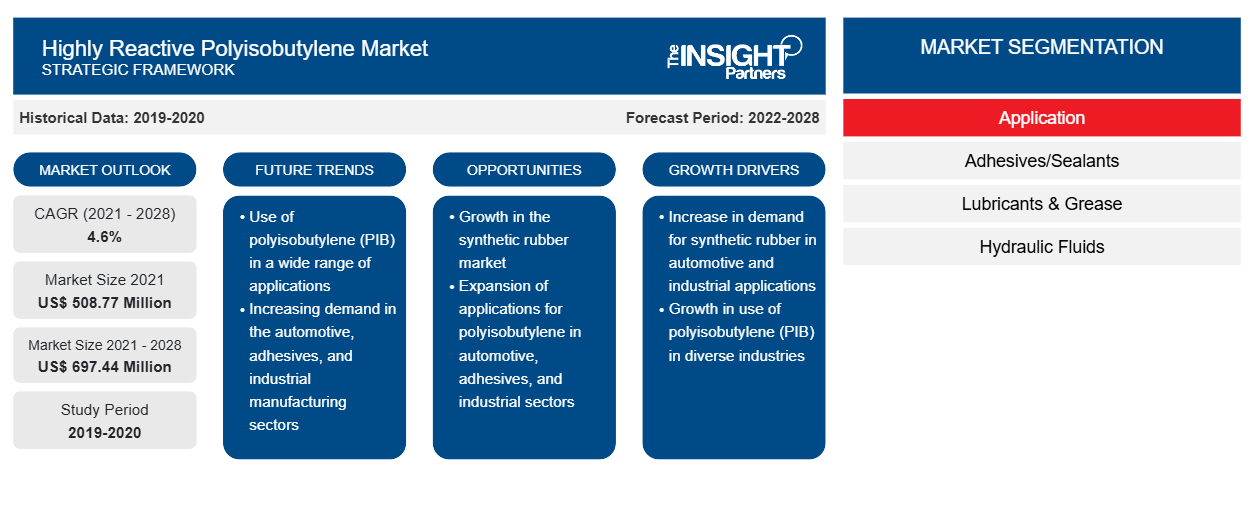Der Markt für hochreaktives Polyisobutylen soll von 508,77 Millionen US-Dollar im Jahr 2021 auf 697,44 Millionen US-Dollar im Jahr 2028 anwachsen; von 2021 bis 2028 wird mit einer durchschnittlichen jährlichen Wachstumsrate von 4,6 % gerechnet.
Hochreaktives Polyisobutylen (HR-PIB) ist ein wichtiges Zwischenprodukt bei der Herstellung von leistungsstarken Kraftstoff- und Schmierstoffadditiven, wie beispielsweise Dispergiermitteln für Motoröle oder Kraftstoffreinigern. Die Hochleistungs-Schmierstoffadditive ermöglichen eine kraftstoffeffizientere Motorkonstruktion.
Im Jahr 2020 hatte der asiatisch-pazifische Raum den größten Umsatzanteil am Markt für hochreaktives Polyisobutylen . Das Segment Schmierstoffe und Fette ist der größte Verbraucher von HR-PIB im asiatisch-pazifischen Raum. Die Verbreitung des Automobilsektors in der Region steigert die Nachfrage nach Hydraulikflüssigkeiten und Schmierstoffen und treibt damit den Bedarf an HR-PIB an. Darüber hinaus treibt die zunehmende Industrialisierung und Bauwirtschaft im asiatisch-pazifischen Raum die Nachfrage nach Maschinen und Ausrüstung in den entsprechenden Produktionsstätten an.
Passen Sie diesen Bericht Ihren Anforderungen an
Sie erhalten kostenlose Anpassungen an jedem Bericht, einschließlich Teilen dieses Berichts oder einer Analyse auf Länderebene, eines Excel-Datenpakets sowie tolle Angebote und Rabatte für Start-ups und Universitäten.
-
Holen Sie sich die wichtigsten Markttrends aus diesem Bericht.Dieses KOSTENLOSE Beispiel umfasst eine Datenanalyse von Markttrends bis hin zu Schätzungen und Prognosen.
Auswirkungen der COVID-19-Pandemie auf den Markt für hochreaktives Polyisobutylen
Im Jahr 2020 mussten verschiedene Branchen ihre Produktion aufgrund von Lieferkettenunterbrechungen aufgrund der Schließung nationaler und internationaler Grenzen drosseln, was zu einer geringen Nachfrage nach HR-PIB führte. Die Pandemie verursachte Störungen in den Herstellungsprozessen aufgrund von Beschränkungen, die von Regierungsbehörden in verschiedenen Ländern hinsichtlich der Mitarbeiterzahl in den Werken und des Transports verhängt wurden, was es für die Mitarbeiter schwierig machte, zu den Arbeitsstätten und wieder nach Hause zu pendeln. HR-PIB findet wichtige Anwendung bei der Herstellung von Hochleistungs-Kraftstoff- und Schmierstoffzusätzen. Die gesunkene Nachfrage nach Kraftstoff aus verschiedenen Branchen behinderte den Verbrauch von Kraftstoffzusätzen und behinderte schließlich den Verkauf von HR-PIB. Als die Volkswirtschaften jedoch im Jahr 2021 begannen, ihren Betrieb wieder anzukurbeln, begann auch die Nachfrage nach HR-PIB allmählich zu steigen.
Markteinblicke
Zunehmender Einsatz von HR-PIB bei der Herstellung von Hochleistungsadditiven für Kraftstoffe und Schmiermittel
HR-PIB ist ein wichtiges Zwischenprodukt, das bei der Herstellung von Hochleistungs-Kraftstoff- und Schmierstoffadditiven Anwendung findet . Aufgrund seiner hohen Reaktivität wird es bei der Herstellung von Additiven herkömmlichem Polyisobutylen vorgezogen. Die Hauptfunktion von Schmierstoffadditiven besteht darin, die Eigenschaften des Grundöls unter verschiedenen Betriebsbedingungen zu verbessern. Darüber hinaus unterstützen Hochleistungs-Schmierstoffadditive kraftstoffeffizientere Motorkonstruktionen. Dispergiermittel sind Schmierstoffadditive, die dabei helfen, die Bildung von Schlamm, Lack und anderen Ablagerungen auf kritischen Oberflächen zu verhindern. Die Nachfrage nach HR-PIB wächst bei der industriellen Synthese von Dispergiermitteln für Motoröle für Kraftfahrzeuge. Die Präsenz starker additiver Fertigungsstandorte in den USA, Europa und im asiatisch-pazifischen Raum macht diese zu Hauptabnehmern von HR-PIB. Daher fördert die zunehmende Verwendung von HR-PIB bei der Herstellung von Hochleistungs-Kraftstoff- und Schmierstoffadditiven das Marktwachstum.
Anwendungseinblicke
Basierend auf der Anwendung wurde der Markt für hochreaktives Polyisobutylen in Klebstoffe/Dichtstoffe, Schmiermittel und Fette, Hydraulikflüssigkeiten, Metallbearbeitungsflüssigkeiten und andere unterteilt. Das Segment Schmiermittel und Fette hatte im Jahr 2020 den größten Marktanteil. Schmiermittel wie Motoröle, Getriebeöle, Schmierfette und Kompressoröle werden in der Automobil-, Flugzeug-, Schiffs- und Maschinenbauindustrie stark verbraucht. HR-PIB trägt dazu bei, die Gesamtleistung von Schmiermitteln zu verbessern.
TPC Group; RB PRODUCTS INC.; BASF PETRONAS Chemicals Sdn. Bhd; Shandong Hongrui New Material Technology Co., Ltd; Daelim Co., Ltd.; Chevron Corporation; The Lubrizol Corporation; KEMAT Polybutenes; Weifang Binhai Petro-chem Co., Ltd.; und Nelson Brothers Incorporated gehören zu den wichtigsten Marktteilnehmern auf dem Markt für hochreaktives Polyisobutylen. Akteure auf dem Markt für hochreaktives Polyisobutylen konzentrieren sich stark auf die Entwicklung hochwertiger und innovativer Produkte, um die Anforderungen der Kunden zu erfüllen.
Regionale Einblicke in den Markt für hochreaktives Polyisobutylen
Die regionalen Trends und Faktoren, die den Markt für hochreaktives Polyisobutylen im gesamten Prognosezeitraum beeinflussen, wurden von den Analysten von Insight Partners ausführlich erläutert. In diesem Abschnitt werden auch die Marktsegmente und die Geografie für hochreaktives Polyisobutylen in Nordamerika, Europa, im asiatisch-pazifischen Raum, im Nahen Osten und Afrika sowie in Süd- und Mittelamerika erörtert.

- Erhalten Sie regionalspezifische Daten zum Markt für hochreaktives Polyisobutylen
Umfang des Marktberichts über hochreaktives Polyisobutylen
| Berichtsattribut | Details |
|---|---|
| Marktgröße im Jahr 2021 | 508,77 Millionen US-Dollar |
| Marktgröße bis 2028 | 697,44 Millionen US-Dollar |
| Globale CAGR (2021 - 2028) | 4,6 % |
| Historische Daten | 2019-2020 |
| Prognosezeitraum | 2022–2028 |
| Abgedeckte Segmente |
Nach Anwendung
|
| Abgedeckte Regionen und Länder |
Nordamerika
|
| Marktführer und wichtige Unternehmensprofile |
|
Dichte der Marktteilnehmer für hochreaktives Polyisobutylen: Auswirkungen auf die Geschäftsdynamik verstehen
Der Markt für hochreaktives Polyisobutylen wächst rasant, angetrieben durch die steigende Nachfrage der Endverbraucher aufgrund von Faktoren wie sich entwickelnden Verbraucherpräferenzen, technologischen Fortschritten und einem größeren Bewusstsein für die Vorteile des Produkts. Mit steigender Nachfrage erweitern Unternehmen ihr Angebot, entwickeln Innovationen, um die Bedürfnisse der Verbraucher zu erfüllen, und nutzen neue Trends, was das Marktwachstum weiter ankurbelt.
Die Marktteilnehmerdichte bezieht sich auf die Verteilung der Firmen oder Unternehmen, die in einem bestimmten Markt oder einer bestimmten Branche tätig sind. Sie gibt an, wie viele Wettbewerber (Marktteilnehmer) in einem bestimmten Marktraum im Verhältnis zu seiner Größe oder seinem gesamten Marktwert präsent sind.
Die wichtigsten auf dem Markt für hochreaktives Polyisobutylen tätigen Unternehmen sind:
- TPC-Gruppe
- Gesellschaften, beginnend mit RB
- BASF PETRONAS Chemicals Sdn. Bhd
- Shandong Hongrui Neue Materialtechnologie Co., Ltd.
- Daelim Co., Ltd.
Haftungsausschluss : Die oben aufgeführten Unternehmen sind nicht in einer bestimmten Reihenfolge aufgeführt.

- Überblick über die wichtigsten Akteure auf dem Markt für hochreaktives Polyisobutylen
Bericht-Spotlights
- Progressive Trends in der hochreaktiven Polyisobutylen-Industrie helfen den Akteuren bei der Entwicklung wirksamer langfristiger Strategien
- Von Unternehmen verfolgte Geschäftswachstumsstrategien zur Gewährleistung des Wachstums in entwickelten und sich entwickelnden Märkten
- Quantitative Analyse des Marktes für hochreaktives Polyisobutylen von 2019 bis 2028
- Schätzung der weltweiten Nachfrage nach HR-PIB
- Porters Fünf-Kräfte-Analyse zur Veranschaulichung der Wirksamkeit der in der Branche tätigen Käufer und Lieferanten
- Aktuelle Entwicklungen zum Verständnis des wettbewerbsorientierten Marktszenarios
- Markttrends und -aussichten sowie Faktoren, die das Wachstum des Marktes für hochreaktives Polyisobutylen vorantreiben und bremsen
- Unterstützung im Entscheidungsprozess durch Aufzeigen von Marktstrategien, die das kommerzielle Interesse untermauern
- Größe des Marktes für hochreaktives Polyisobutylen an verschiedenen Knotenpunkten
- Detaillierte Übersicht und Segmentierung des Marktes sowie der HR-PIB-Branchendynamik
- Größe des Marktes für hochreaktives Polyisobutylen in verschiedenen Regionen mit vielversprechenden Wachstumschancen
Markt für hochreaktives Polyisobutylen
Anwendung
- Klebstoffe/Dichtstoffe
- Schmiermittel und Fette
- Hydraulikflüssigkeiten
- Metallbearbeitungsflüssigkeiten
- Sonstiges
Firmenprofile
- TPC-Gruppe
- Gesellschaften, beginnend mit RB
- BASF PETRONAS Chemicals Sdn. Bhd
- Shandong Hongrui Neue Materialtechnologie Co., Ltd.
- Daelim Co., Ltd.
- Chevron-Konzern
- Die Lubrizol Corporation
- KEMAT Polybutene
- Weifang Binhai Petrochem Co., Ltd.
- Nelson Brothers Incorporated
- Historische Analyse (2 Jahre), Basisjahr, Prognose (7 Jahre) mit CAGR
- PEST- und SWOT-Analyse
- Marktgröße Wert/Volumen – Global, Regional, Land
- Branchen- und Wettbewerbslandschaft
- Excel-Datensatz
Aktuelle Berichte
Erfahrungsberichte
Grund zum Kauf
- Fundierte Entscheidungsfindung
- Marktdynamik verstehen
- Wettbewerbsanalyse
- Kundeneinblicke
- Marktprognosen
- Risikominimierung
- Strategische Planung
- Investitionsbegründung
- Identifizierung neuer Märkte
- Verbesserung von Marketingstrategien
- Steigerung der Betriebseffizienz
- Anpassung an regulatorische Trends























 Kostenlose Probe anfordern für - Markt für hochreaktives Polyisobutylen
Kostenlose Probe anfordern für - Markt für hochreaktives Polyisobutylen